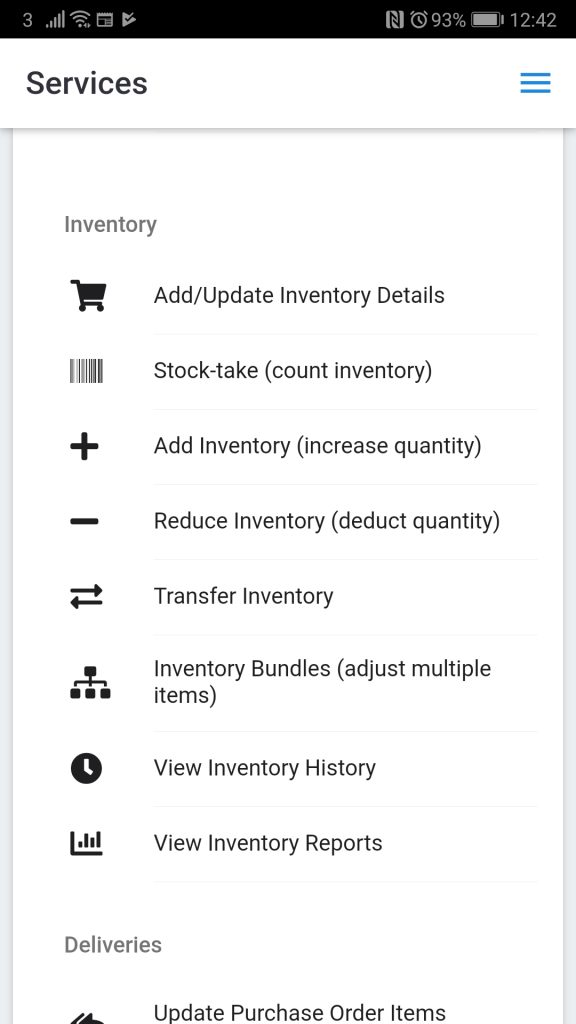How Can We Help?
Inventory
The platform enables you to track adjustments made to inventories. Multiple locations are supported, and adjustments for each location is accounted for separately.
Where multiple locations are involved, each inventory record would be associated with a single unique location.
Prerequisite
Inventory is the main point of entry for adding inventory data to the platform.
In order to add or import inventory, you first need to customize the Record Inventory Data Capture fields so that you can gather the details you need about them.

Location is a recommended field to have. You can set up or manage inventory locations according to the guidelines given.
When adding inventory, each inventory record in a location will need a unique identifier (a unique ID, SKU, etc, as long as it’s unique). This is what will be used when scanning barcodes or NFC tags.
After that, the next step would be to add the inventory data to the platform.
Adding inventory records from the web app
Option 1 – Add inventory records individually
Go to the Manage Inventory > Inventory page, then click on the Add New Records button > Add A Single Record. Fill in the form on the new page that follows.
To edit the record, find it on the table, then go to Actions > Edit.
Option 2 – Import multiple inventories using a CSV file
Go to the Manage Inventory > Inventory page, then click on the Add New Records button > Import From CSV. Upload a CSV file based on the guidelines shown on the new page.
Existing records can be edited by uploading the CSV, provided that the Barcode/NFC Tag ID, and location value are the same.
Option 3 – Import from Apps such as QuickBooks, Square or Shopify
If your account is connected with QuickBooks Online, Square, or Shopify, you can import your inventories.
To do so, go to the Manage Inventory > Inventory page, then click on the Add New Records button > Import from (QuickBooks, or Square, or Shopify).
Option 4 – Use an online spreadsheet
Go to Manage Inventory > Inventory page, click on the Scan To Spreadsheet button. On the new page, use our smartphone app to scan barcodes or NFC tags, then populate the rest of the spreadsheet.
Option 5 – Use Bluetooth, USB or Wireless scanners
Go to the Bluetooth & USB scanners page, then choose Record Inventory from the dropdown menu.
When barcodes are then scanned, the spreadsheet at the bottom of the page will be populated with the scanned values. You then need to fill in the rest of the cells with the corresponding data, then save the spreadsheet.
Adding inventory records from the smartphone app
If you have barcodes or NFC tags, you can scan them using our iOS & Android apps, then fill in the form with your inventory details.
On the smartphone app, go to Add/Update Inventory Details, to add new or edit existing inventory.

Adding inventory records via automated workflows
Using Zapier
Using Zapier, you can automate how inventory records are added to your account. For example, you could edit a Google Sheet row, and have the data on that row automatically used to create an inventory record.
You first need to set up a Zap trigger.
After that, choose the app Ventipix Asset & Inventory Manager, and the action Create Inventory.

Click on Continue, then authenticate your account.
In the step that follows, map data from your Zap trigger on to the fields that you want to populate automatically.

Proceed to then test the integration, and turn the Zap on.
Using Microsoft Power Automate
Using Microsoft Power Automate, you can also automate how assets are added to your account from other platforms (flows). For example, you could set up a trigger or schedule whereby data from the source platform is automatically used to create an asset in your account.
In your Power Automate account, set up a new flow, for example, “Automated – from blank” or “Scheduled – from blank“.

After that, choose the connector with the data source, and its appropriate action. If using Excel, you would choose, “list rows present in a table“. For example:

If using Google Sheets, you would choose, “Get rows“. For example:

Once the connector has been set up with all its authentication requirements, and file location details, proceed to add a new step.
In this new step, search for “Ventipix Asset and Inventory” connector. Then, under its Action menu, select, “Create an asset or inventory record“.

In the new prompt, under the Services dropdown, select “Inventory Tagging”.

In the input fields that will then be displayed, select the dynamic content that should go on to them.

On the “Apply to each” prompt, click on the “Create an asset or inventory record” title to expand it.

After that, continue to populate the necessary or required fields with more dynamic content. For example:

Once that’s done, save the entire flow set up, then let it run.
If needed, you can of course add further steps in the workflow.